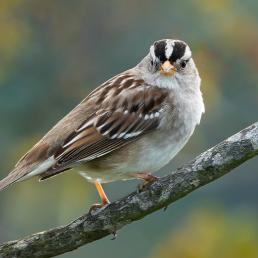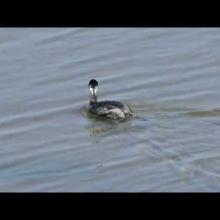

Join BirdNote tomorrow, November 30th!
Illustrator David Sibley and actor H. Jon Benjamin will face off in the bird illustration battle of the century during BirdNote's Year-end Celebration and Auction!
Eared Grebes eat brine shrimp and aquatic insects for sustenance, but rigid exoskeletons make them hard to digest. So these grebes – along with their other grebe cousins – evolved to use their feathers as a way to slow down digestion. The feathers form dense balls in the digestive tract and appear to slow the passage of food long enough that the food can be safely liquified. The bird then regurgitates the tough bits within a ball of feathers. The Pied-billed Grebe shown here is feeding feathers to her chicks.
BirdNote®
Why Do Grebes Eat Their Feathers?
Written by Bob Sundstrom
This is BirdNote.
[Eared Grebe call, https://macaulaylibrary.org/asset/106819#_ga=2.152978107.304284454.1581…, 0.05-.08]
Some birds are just misunderstood and have been for centuries. Take the Eared Grebe, for example. The earliest description in the North American literature--dating from 1577 and based on Aztec observations--notes, “Its food is its feathers, only sometimes it eats fish.”
[Eared Grebe call,
https://macaulaylibrary.org/asset/133198#_ga=2.87469722.304284454.15815…, 2.17-2.20]
Strange as it sounds, grebes do indeed eat their own feathers. Eared Grebes eat mainly brine shrimp and aquatic insects, which have rigid exoskeletons, making them both tough to digest and potentially damaging to the intestines.
So, grebes evolved to use their feathers as a way to slow down digestion. After the bird swallows them, the feathers enter a three-part stomach — first a storage chamber, then a gizzard, and lastly a pouch. The feathers form dense balls in both the gizzard and final pouch and appear to slow the passage of food long enough that the food can be safely liquified.
The tough bits are then regurgitated within a ball of feathers, much the way owls spit up pellets of bones from their prey. A grebe may pop out as many as six feather balls in an evening.
[Eared Grebe call]
For BirdNote, I’m Michael Stein.
###
Senior Producer: Mark Bramhill
Producer: Sam Johnson
Managing Editor: Jazzi Johnson
Content Director: Jonese Franklin
Bird sounds provided by The Macaulay Library of Natural Sounds at the Cornell Lab of Ornithology, Ithaca, New York. Eared Grebe call, ML106819, recorded by Randolph Little. ML133198 recorded by Gregory Budney.
BirdNote’s theme was composed and played by Nancy Rumbel and John Kessler.
© 2021 BirdNote January 2021/2025 Narrator: Michael Stein
ID# grebe-01-2021-01-15 grebe-01
Aztec quote from BNA article https://birdsna.org/Species-Account/bna/species/eargre/other
https://bioone.org/journals/The-Wilson-Journal-of-Ornithology/volume-12…
https://www.hbw.com/news/why-do-grebes-eat-feathers
https://www.allaboutbirds.org/guide/Red-necked_Grebe/overview
This bizarre dietary adaptation adds another benefit: the extra slow passage of food permits a grebe’s body to retain nearly all the food’s nutrients—with the help of a few feathers.




